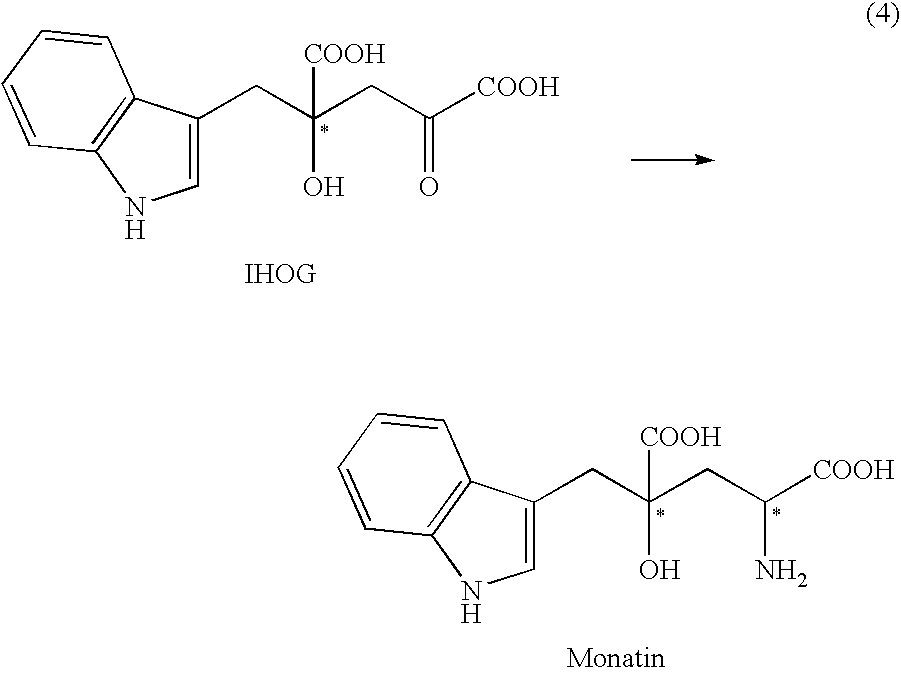Mutated D-aminotransferase and method for producing optically active glutamic acid derivatives using the same
a daminotransferase and d-aminotransferase technology, applied in the field of daminotransferase, can solve the problems of impeded practical production on an industrial scale, difficult to efficiently produce (2r, 4r)-monatin at a high ratio, and inefficient (2r, 4r)-monatin production
- Summary
- Abstract
- Description
- Claims
- Application Information
AI Technical Summary
Benefits of technology
Problems solved by technology
Method used
Image
Examples
example 1
Screening for Microorganisms Having D-Aminotransferase Activity for PHOG Amination
[0292] Microbial strains to be tested were inoculated on bouillon agar plate (Eiken Chemical Co., Ltd.), and cultured at 30° C. for 24 hours. The cells were then inoculated at about 5% (w / v) into 1 ml of a reaction liquid composed of 100 mM Tris-HCl (pH 7.6), 50 mM PHOG, 100 mM D-glutamic acid, 100 mM D-alanine, 1 mM pyridoxal-5′-phosphate and 0.5% (v / v) toluene. The reaction liquid was then incubated at 30° C. for 16 hours. After the completion of the reaction, produced PHG was analyzed. As a result, the 2R-PHG producing activity from PHOG was found in the microorganisms shown in Table 2. Thus (2R, 4S)-PHG and (2R, 4R)-PHG were produced from PHOG.
TABLE 2PHG generation(mM)Strains(2R,4R)(2R,4S)Bacillus macerans AJ1617*7.17.0Bacillus sphaericus ATCC 1020816.616.5Bacillus pulvifaciens AJ13272.82.6Paenibacillus larvae subsp. pulvifaciens ATCC 135373.02.8Paenibacillus macerans ATCC 82446.56.5Bacillus len...
example 2
Cloning of Dat Gene (Bmdat) Derived From Bacillus Macerans AJ1617 Strain and Construction of Expression-Plasmid
(1) Preparation of Chromosomal DNA
[0293]Bacillus macerans AJ 1617 strain was cultured using 50 mL of bouillon medium at 30° C. overnight (preculture). 5 mL of this cultured medium was inoculated into a main culture consisting 50 mL of bouillon medium. After culturing until a logarithmic growth late phase, 50 mL of the cultured broth was centrifuged (12000×g, 4° C., 15 min.) to harvest cells. From thus obtained cells, chromosomal DNA was prepared in accordance with standard methods.
(2) Isolation of Bmdat Gene From a Genomic Library
[0294] 1 U of a restriction enzyme EcoRI was added to 30 μg of chromosomal DNA derived from Bacillus macerans AJ1617, and incubated at 37° C. for 3 hours to perform partial digestion. Subsequently, fragments of 3 to 6 kbp were collected from this partially digested DNA by agarose gel electrophoresis. These DNA fragments were ligated to 1 μg o...
example 3
Conversion of IHOG to 2R-Monatin and Conversion of PHOG to 2R-PHG Using E. Coli Expressing D-Aminotransferase Derived From Bacillus Macerans (BMDAT)
(1) Preparation of BMDAT-Expressing E. Coli
[0297]E. coli transformants with pUCBMDAT were inoculated to 3 mL of LB medium (1 g / dL of bacto tryptone, 0.5 g / dL of yeast extract and 1 g / dL of NaCl) containing 0.1 mg / mL of ampicillin and 0.1 mM isopropyl-1-thio-β-D-galactopyranoside (IPTG). The medium was then cultured with shaking at 37° C. for 16 hours. Cells were collected from the cultured medium and washed to prepare cells of the BMDAT-expressing E. coli.
(2) Reaction With Washed Microbial Cells of BMDAT-Expressing E. Coli
[0298] The microbial cells prepared in (1) above were suspended at 2% (w / v) in 1 mL of a reaction liquid composed of 100 mM Tris-HCl (pH 8.0), 50 mM IHOG, 200 mM D-alanine, 1 mM pyridoxal-5′-phosphate and 0.5% (v / v) toluene. The suspension was then incubated with shaking at 33° C. for 16 hours, and the amount of 2...
PUM
| Property | Measurement | Unit |
|---|---|---|
| pH | aaaaa | aaaaa |
| pH | aaaaa | aaaaa |
| concentration | aaaaa | aaaaa |
Abstract
Description
Claims
Application Information
 Login to View More
Login to View More - R&D
- Intellectual Property
- Life Sciences
- Materials
- Tech Scout
- Unparalleled Data Quality
- Higher Quality Content
- 60% Fewer Hallucinations
Browse by: Latest US Patents, China's latest patents, Technical Efficacy Thesaurus, Application Domain, Technology Topic, Popular Technical Reports.
© 2025 PatSnap. All rights reserved.Legal|Privacy policy|Modern Slavery Act Transparency Statement|Sitemap|About US| Contact US: help@patsnap.com



